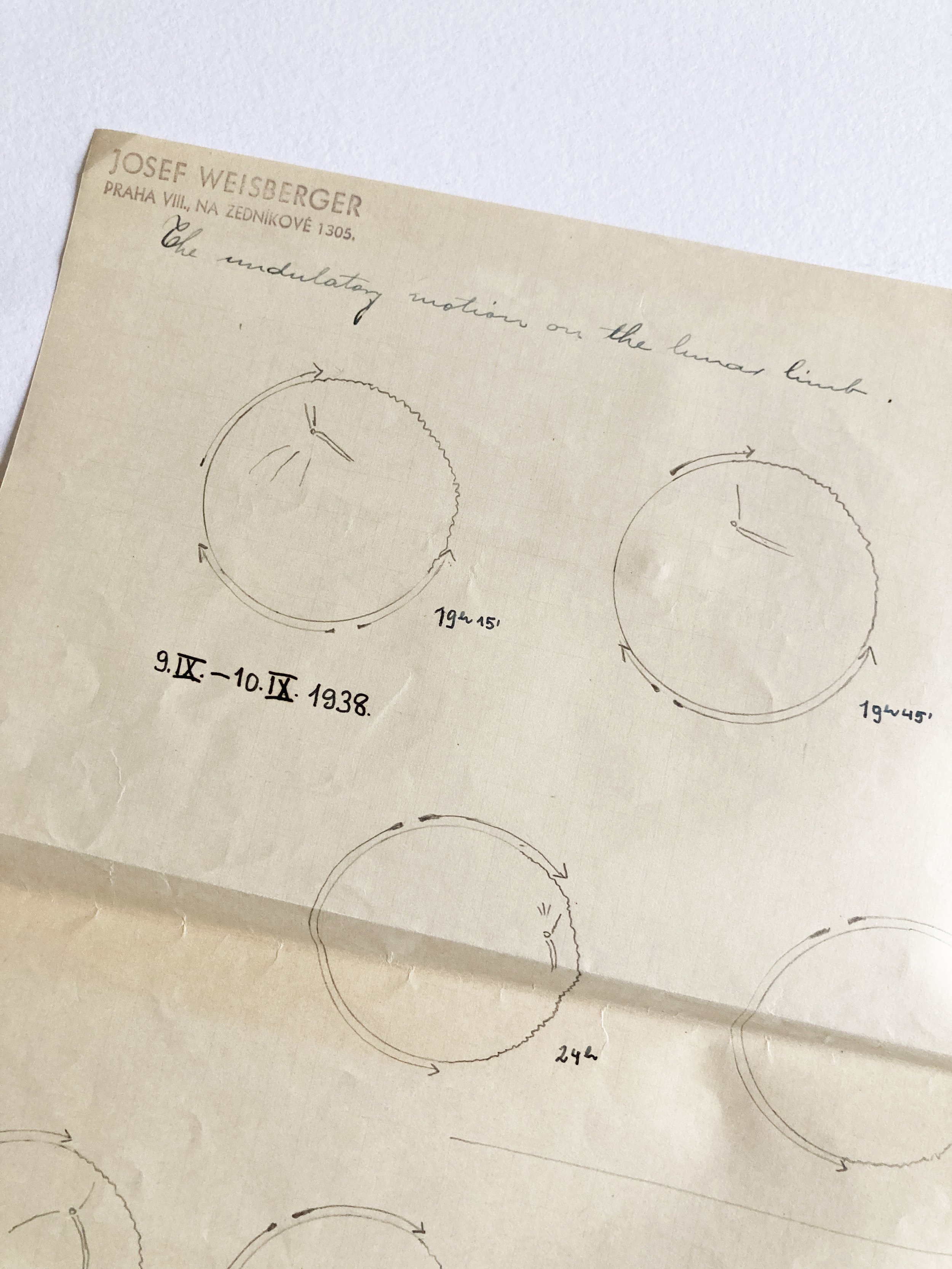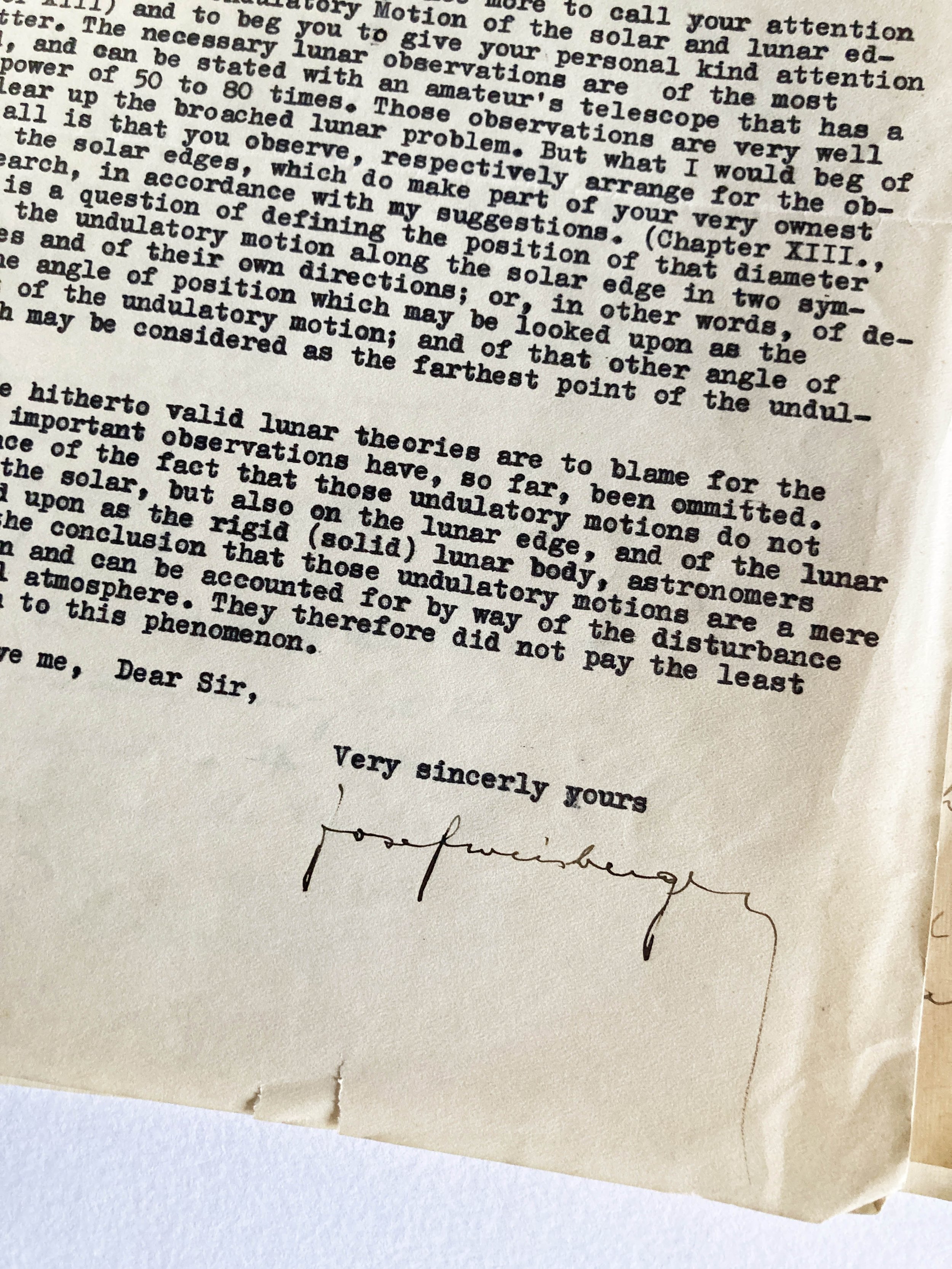HETERODOX ASTRONOMY: THE MOON'S SURFACE UNMARKED?




HETERODOX ASTRONOMY: THE MOON'S SURFACE UNMARKED?
WEISBERGER, Josef (1880–1943)
Original sketched solar observations, with a group of letters and the text 'Astronomers Ought to Reply' on the nature of the moon, Vienna and Prague, 1937–1938; sent to the Cambridge astronomer F.J.M. Stratton
AN EXTRAORDINARY RECORD OF AMATEUR ASTRONOMY, MARGINAL SCIENCE AND – SIMULTANEOUSLY – NAZI PERSECUTION.
A small archive of materials, comprising: one signed typed letter, one signed autograph letter, Wesberger's calling card, seven typescripts, and three sheets of manuscript illustrations. All documents from the personal collection of F.J.M. Stratton (1881–1960). Remnants of the mailing box preserved, with the Czech censorship stamp.
Josef Weisberger (1880–1943) was an amateur astronomer who developed a highly idiosyncratic theory of lunar features – which, it must be said, were still deeply contentious in his lifetime.
Weisberger's theory was discussed by Patrick Moore in the Journal of the British Astronomical Association:
"[Weisberger] solved the whole problem very simply by denying that there were any lunar mountains or craters at all – merely storms and cyclones in a dense lunar atmosphere."
To say that he solved the problem 'simply', however, is to ignore the huge amount of work that Weisberger put into his researches, and also the speculative extent of his theory. Not only did Weisberger dismiss the idea of lunar craters, but he also theorized that underneath the lunar atmosphere was a world similar to our own, even including animal and vegetable life.
The central document here is Weisberger's text 'Astronomers Ought to Reply'. This he described in one of the letters offered here as 'a popular easily comprehensible' text. In his faulty English Weisberger wrote of this, 'I dare to dedicate [it] to you in deepest reverence'.
This is a glimpse of the extraordinary personal and political circumstances surrounding these documents: Weisberger's first letter is attressed from Vienna, 1937, and is more formal in tone. By the second letter, send on 17 October 1938, Weisberger's situation has changed dramatically. He is now in Prague, and though he writes on his own headed paper he is clearly much diminished. He talks of Stratton's kind regard for his health, and continues:
"I'm still reconvalescent, but I'm already at home. The German racial laws deprived me of all my fortune and living. My family and I have to care very hard as the political situation made it still more difficult to found [sic] a new living. In the pastime I could rely on my reserve I had here. But in the last yeasr I had to afford all my money to defray the costs of my research work."
This is an ambivalent sentiment: Weisberger was clearly stretching himself financially and mentally. Stratton seems to have supported Weisberger, in spite of the fact that he cannot possibly have believed his theory. A suggestion of Stratton's sympathy is that he has asked Weisberger to observe not only the moon but also the solar limb. Weisberger has sent Stratton a long series of drawings, preserved here, that show 'undulations', as well as sunspots. These were perhaps of greater interest to Stratton, and may be an indication of him pushing Weisberger into more orthodox astronomical territory.
Tragically Weisberger was not to survive the Nazi regime. In November 1942 he was transferred to the notorious Theresienstadt Ghetto, and then, on 20 January 1943 to Auschwitz, where he was murdered.
All of the enclosed documents are scarce: we can find no record of 'Astronomers Ought to Reply' worldwide.
Overall the documents are in very good condition; the letters a somewhat handled and worn; all paper is age-toned; the separate typescripts are all in exceptionally good condition, noting only uniform browning and some light bumping to the corners. The original folder is largely disintegrated but is retained as it adds to the provenance and features the Czech postal markings of the time, including the stamped 'Censurovano' censorship mark.

